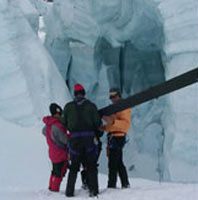One Shot Pass
I naively asked why they call it "One Shot Pass" and got a laugh in
response. It's the best shot you have for flying a direct route to
Kahiltna Base Camp. Our plane lifted up out of the cloud layer, and the three great
peaks of the Alaska Range—Foraker, Hunter, and
Denali—rose above the moon in full view. Astronaut
John Grunsfeld
couldn't resist grinning. Next to me sat Dr.
Peter Hackett, and
although he has climbed Denali eight times, the site of "the great
one" from the air visibly moved him.
Our pilot Paul Roderick skirted over One Shot Pass, bringing the
plane in low over the crevasse fields of the Kahiltna, the longest
glacier in the Alaska Range. We landed on skis in the white powder
snow and came to a stop before a snow hill cluttered with tents.
Most climbers are on their way up the mountain; the others have
returned from their attempts. So far this year, only 18 percent of
Denali's 600 climbers have made it to the summit, a very low number
for a mountain that boasts a 50 percent chance of success. It has
been a cold spring in Alaska. Yesterday, eight climbers with
frostbite were flown out to Talkeetna, where Dr.
Howard Donner checked
them out before sending them on to the Thermal Injury Unit at the
Providence Medical Center. Donner, who is volunteering for the Park
Service, flew in after us with volunteer mountain rescue climber
Pete Athans, who has
reached the summit of Everest six times. They are both here as
members of the June patrol on Denali, led by Chief Mountaineer
Ranger Roger Robinson, a man who has spent over 20 years on the
slopes of Denali as a climber and a ranger. The patrol handles all
medical and rescue operations on the mountain; all are strong
climbers and have been trained to conduct high-altitude medical
evacuations by helicopter.
"As you look around here you see a huge expanse of snow, ice, rock,
and mountains. This is not a place where people were designed to
be," marveled Grunsfeld. "Space is the same: humans were not
designed to go into the cold and vacuum of space." Today we filmed
Donner, Athans, and Robinson departing for
Fourteen Medical, which is a four- to six-day climb. Other than 14,200-foot camp,
Kahiltna Base is the only section of the climb up Denali where
climbers can walk unroped in an area the size of three football
fields. Crevasses are our greatest danger, and no one ventures
beyond the probed areas, which are clearly marked with wands. This
is a small island of terra firma amidst a sea of deep cracks.
Tomorrow, we move to our next camp up the glacier at 7,800 feet. We
leave in the early morning to avoid the heat of the midday sun. With
no shade on the glacier, the bright glare from the snow is
inescapable, and the heat oppressive. Grunsfeld will begin measuring
his core temperature, and we expect to see signs of heat stress.
Although Denali is known for its cold, few are warned of the extreme
heat a climber endures in Alaska's northern sun.
It is 8:30 p.m., and we're all wearing sunglasses, hats, and
bandannas to cover our ears and necks from the sun's burn. All
exposed skin must be covered at all times. Now we'll wait for the
sun to move behind the mountains to sleep.

Location: Kahiltna Base
Altitude: 7,200 feet
Air Temp: 62°F
Windspeed: 0 mph

|


|
NOVA documents crevasse rescue training on High
Definition video using a crane.

|
|
|

